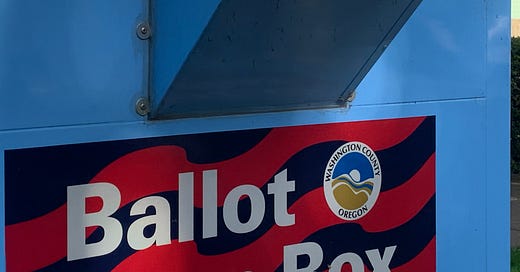No turning back on a different drug addiction paradigm
Getting addicts into or ready for treatment should be the priority for everyone, regardless of their original position on Measure 110
Voter approval of Measure 110 reflected that 60 percent of Oregonians thought it was time to change the paradigm for treating drug addiction. Implementation of Measure 110 and Senate Bill 755 has been choppy and the open use of illicit drugs on Portland streets have led some to call for Measure 110’s repeal.
As it turns out, people shooting up on street corners is what repeal would look like, followed by police arrests and incarceration. We don’t need to go backward. We need to hit the accelerator going forward to set up functioning, fully staffed behavioral health resource networks. We need to recognize addiction is curable.
What behavioral health experts call substance use disorder (SUD) covers a wide expanse of why people get hooked. The National Institute of Drug Abuse lists reasons such as feeling good, forgetting problems, relieving stress, improving performance or yielding to pressure or curiosity. Then there are people who become dependent through overprescribed pain pills.
Addiction is More Complex Than Drugs
“Addiction is a complex, but treatable disease that affects brain function and behavior,” according to the Institute. It includes alcoholism, which can be as visible in bar parking lots as drug use on the street.
No single treatment works for everyone, but treatment needs to be readily available. Effective treatment addresses underlying causes and other mental disorders, not just drug use. Counseling is a common form of drug therapy. Medications are also an important element for many patients. Detoxification does little by itself to change long-term drug abuse. You can see why a jail cell isn’t the perfect drug therapy setting, even though 65 percent of the 2.3 million men and women in American prisons and jails meet the criteria of ‘addicted’.
It has taken a while for Americans to warm up to treating drug abuse instead of just condemning it, despite staggering statistics about who is addicted. Citing 2017 data, 443,000 adolescents between 12 and 17 suffered an alcohol use disorder and 741,000 adolescents suffered from an illicit drug disorder. Those are just the kids.
One in seven young adults, 15 million adults over age 26 and 1 million older adults battle substance use. Both men and women are addicted. Addiction rates are higher among minority groups. Unemployed Americans are twice as likely to suffer from addiction. Numbers like that should shout National Catastrophe, not call the cops.
So why isn’t Oregon doing a better job of addressing addiction, especially street addiction? There has been some administrative fumbling, but the primary reason is a lack of trained behavioral health staff. Oregon has money, some of it from opioid settlements cases. According to a NPR story from last year, 30 percent of current jobs in the addiction and recovery workforce were unfilled. More people are being wooed to the behavioral health field, but many behavioral staff members are emotionally burned out and quit.
Harm Reduction
Harm-reduction techniques, the first steps in drug use cessation, are more appropriate than handcuffs to address street drug use or use by camping homeless people. Again, this takes trained staff, which is in short supply. Behavioral health clinics use peer counselors, men and women who have been in addiction recovery for two or more years and can offer street-wise advice about deciding to get help and staying clean. The community can boost support for these peer counselors.
Portland should consider closing off major parts of downtown and other sensitive areas to open use. There are many more addicts using drugs in their homes or offices, but street use is a like an open community sore. Workers and large and small businesses are fleeing downtown in disgust. California Governor Gavin Newsom called on the National Guard to clean up San Francisco streets. That’s too extreme.
To get users off the street in Portland should make sure addicts have a safe place to go, preferably where they can access treatment when they are ready.
The Clinching Argument
Here’s the clincher. According to the National Institute on Drug Abuse, roughly 75 percent of the people who seek treatment recover successfully from addiction. We would spend money on almost anything with a return rate that good.
Sadly, of the estimated 40 million Americans age 12 and older who suffer from addiction in 2020, only 4 million sought treatment. That’s a lousy percentage, aided no doubt by the stigma of being outed as an addict. The poor percentage also reflects the absence of adequate programs and staff to treat them if they did show up.
Here’s an idea. If you are disgusted about street drug abuse, don’t blame Measure 110. Instead, call your city councilman or legislator and urge them to work with behavioral health activists to recruit, train and hire passionate men and women to treat addiction. While you’re at it, send a note to the behavioral health provider nearest you and encourage them to treat the staff they do have well and take care to avoid burnout.
You don’t have to be addicted to be affected by addiction. Family members, fellow workers, members of your congregation and your neighbors could be suffering quietly, hoping to keep their addiction invisible and under control.
Unfortunately, addiction is an unforgiving disease, which is what we must remember – it is a disease, a treatable disease, not a social scourge or mark of failure. We shouldn’t care why or how someone became addicted. We should only care that people get the treatment they need when they are ready to be treated. That requires community patience and determination to see the people behind the addiction, not just the addiction.
Gary Conkling has been a newsman, congressional aide and public affairs professional for more than 50 years.
Mark Hester will suggest other ideas for responding to the failures of Measure 110 in a column that will post Thursday.





